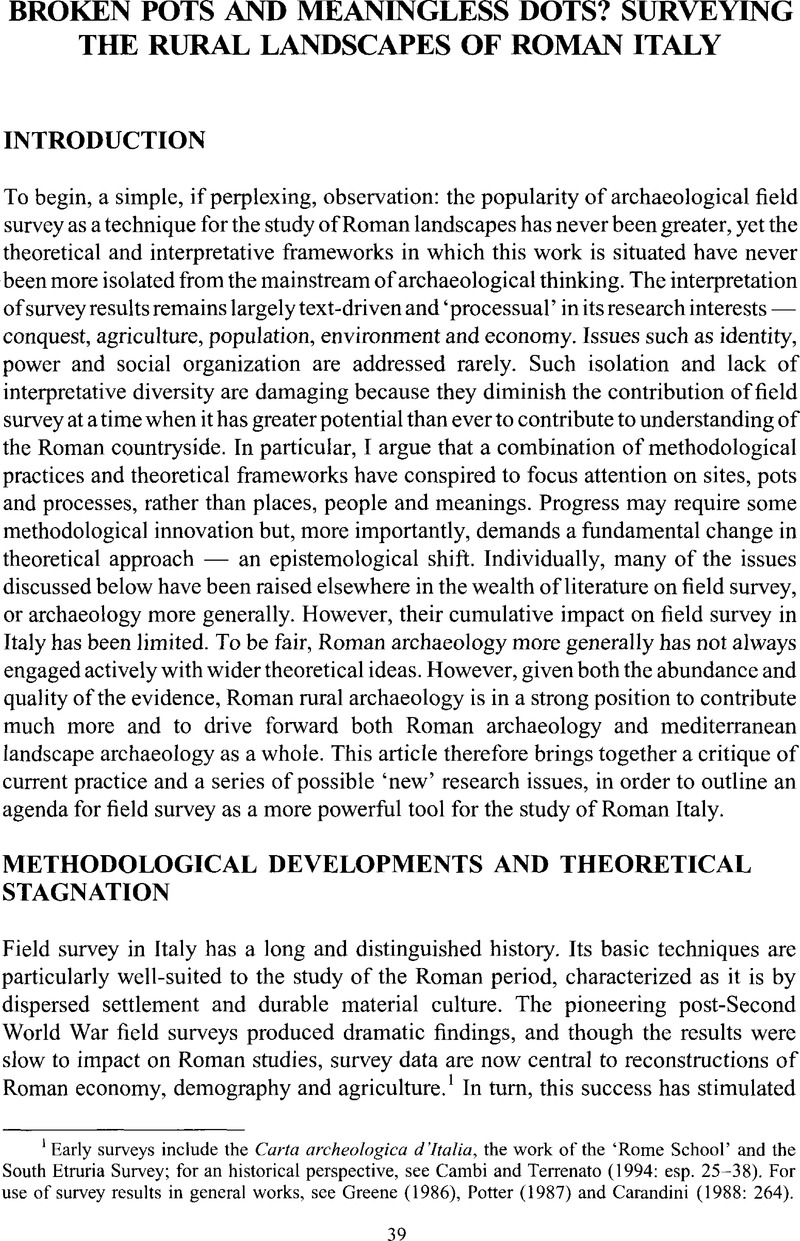Crossref Citations
This article has been cited by the following publications. This list is generated based on data provided by Crossref.
Roth, Roman Ernst
2006.
Black-gloss wares from the acropolis of Capena (La Civitucola, provincia di Roma).
Papers of the British School at Rome,
Vol. 74,
Issue. ,
p.
119.
Witcher, Robert
2008.
(Re)surveying Mediterranean Rural Landscapes: GIS and Legacy Survey Data.
Internet Archaeology,
Ghisleni, Mariaelena
Vaccaro, Emanuele
Bowes, Kim
Arnoldus, Antonia
MacKinnon, Michael
and
Marani, Flavia
2011.
EXCAVATING THE ROMAN PEASANT I: EXCAVATIONS AT PIEVINA (GR).
Papers of the British School at Rome,
Vol. 79,
Issue. ,
p.
95.
Vaccaro, Emanuele
Ghisleni, Mariaelena
Arnoldus-Huyzendveld, Antonia
Grey, Cam
Bowes, Kim
MacKinnon, Michael
Mercuri, Anna Maria
Pecci, Alessandra
Cau Ontiveros, Miguel Ángel
Rattigheri, Eleonora
and
Rinaldi, Rossella
2013.
Excavating the Roman peasant II: excavations at Case Nuove, Cinigiano (GR).
Papers of the British School at Rome,
Vol. 81,
Issue. ,
p.
129.
Taylor, Jeremy
2013.
Encountering Romanitas: Characterising the Role of Agricultural Communities in Roman Britain.
Britannia,
Vol. 44,
Issue. ,
p.
171.
García-Sánchez, Jesús
and
Cisneros, Miguel
2013.
An Off-Site Approach to Late Iron Age and Roman Landscapes on the Northern Plateau, Spain.
European Journal of Archaeology,
Vol. 16,
Issue. 2,
p.
289.
Corsi, Cristina
2016.
Medieval Landscape Archaeology in Italy: A Review.
Medieval Archaeology,
Vol. 60,
Issue. 2,
p.
332.
Campana, Stefano R.L.
2018.
Mapping the Archaeological Continuum.
p.
43.
Chadwick, Adrian M.
2018.
Ulla Rajala and Philip Mills, eds. Forms of Dwelling: 20 Years of Taskscapes in Archaeology (Oxford: Oxbow Books, 2017, 283 pp., 71 figs, incl. 29 b/w photographs, 7 tables, pbk, ISBN 978-1-78570-377-5)..
European Journal of Archaeology,
Vol. 21,
Issue. 2,
p.
317.
Pelgrom, Jeremia
2018.
The Roman rural exceptionality thesis revisited.
Mélanges de l'École française de Rome. Antiquité,
Marzano, Annalisa
2018.
Encyclopedia of Global Archaeology.
p.
1.
Campana, Stefano R.L.
2018.
Mapping the Archaeological Continuum.
p.
1.
Launaro, Alessandro
2018.
Encyclopedia of Global Archaeology.
p.
1.
Smith, Christopher
2018.
J.B. WARD-PERKINS, THE BSR AND THE LANDSCAPE TRADITION IN POST-WAR ITALIAN ARCHAEOLOGY.
Papers of the British School at Rome,
Vol. 86,
Issue. ,
p.
271.
Hernández Sousa, José Miguel
2019.
Paisajes culturales de la Antigüedad en los valles del Tormes y del Corneja (Ávila).
Revista Historia Autónoma,
p.
11.
Launaro, Alessandro
2020.
Encyclopedia of Global Archaeology.
p.
10394.
Castro Garcia, Maria del Mar
2020.
The LiguSTAR Project: Archaeological Survey Techniques as Applied to the Study of Roman Settlement on the Riverbanks of the Lacus Ligustinus (Southwest Spain).
Theoretical Roman Archaeology Journal,
Vol. 3,
Issue. 1,
Marzano, Annalisa
2020.
Encyclopedia of Global Archaeology.
p.
11043.
Van Oyen, Astrid
2020.
The Socio-Economics of Roman Storage.
Barone, Pier Matteo
Wueste, Elizabeth
and
Hodges, Richard
2020.
Remote Sensing Materials for a Preliminary Archaeological Evaluation of the Giove Countryside (Terni, Italy).
Remote Sensing,
Vol. 12,
Issue. 12,
p.
2023.



